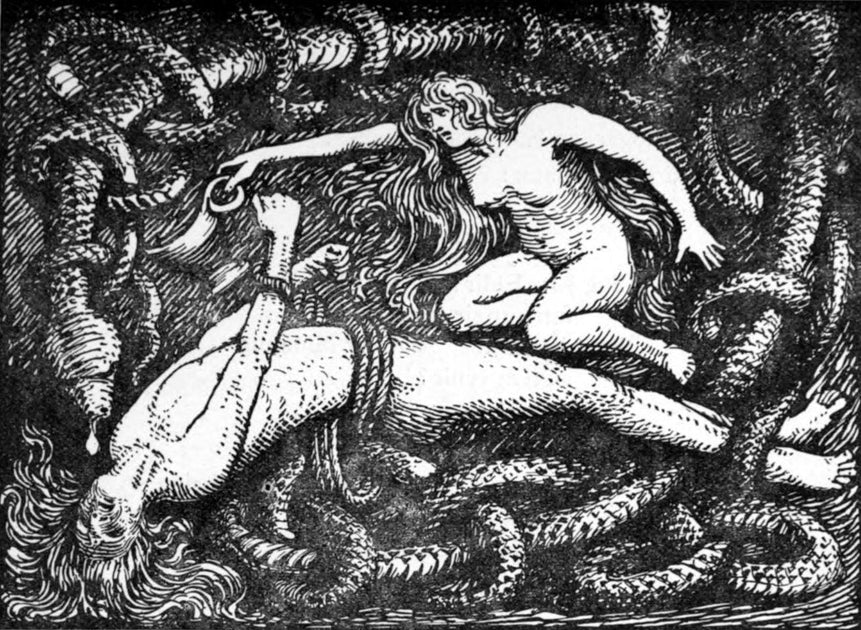Narfi is the Norse god of wrongdoing and the son of Loki and Sigyn. Narfi inherited many of his father's negative traits. He was known for his cunning and trickery, and he was destined to pay for the sins of his father.
The story of Narfi, son of Loki, is convoluted and often conflicting. In one verse of Snorri Sturluson’s Prose Edda, Narfi and Vali are called the sons of Loki. Later, several verses state that Vali is a son of Odin and the giantess Rindr, making him the half-brother of Baldr and Hodr, not Narfi.
Some scholars and historians blame a mistranslation of Old Norse poems handed down through generations. Others blame the confusing timeline of Norse mythology, which isn’t well-sorted in the written accounts available today.
Whatever the case, the confusion surrounding the story of Narfi and the sons of Loki is a prime example of what can happen when people outside of a culture or faith tradition record their history.
What is Narfi the god of?
Narfi is known as the Norse god of wrongdoing.
He is also known as the father of Nótt. The son of Loki, the trickster god, Narfi inherited many of his father’s negative traits. He was known for his cunning and trickery, but mostly, he was known as the son of Loki and Sigyn, destined to pay for the sins of his father.
Like all of Loki’s children, Narfi was born into a situation not of his own making. Fueled by fear of the prophecies of Ragnarök, Odin had already banished Loki’s other children from Asgard. When Loki’s nefarious actions led to Odin’s beloved son Baldr’s death, Narfi’s fate was sealed.
Narfi’s relations to other gods
Narfi is one of the sons of Loki and the only child of Sigyn. His half-brothers are the great wolf Fenrir, the World Serpent Jörmungandr, and Odin’s eight-legged horse Sleipnir. Hel, the goddess of death, is Narfi’s half-sister.
Like many Norse gods, Loki had children with more than one partner. Fenrir, Hel, and Jörmungandr were the children of Loki and the giantess Angrboda. Loki gave birth to Sleipnir while in the form of a mare meant to distract the stallion Svadilfari.
Narfi is the grandson of giants Laufey and Farbauti, the biological parents of Loki. There is little mention of Laufey and Farbauti outside of their role in Loki’s birth. Narfi is also the grandson of Odin, who adopted Loki and brought him from the land of giants to Asgard.
The giantess Nótt is Narfi’s only child. She is the personification of night, with beautiful dark skin. Nótt had a son named Dagr (day) with the Æsir god Dellingr. Odin gave Nótt and Dagr chariots to ride across the sky until Ragnarök, with Dagr bringing light to the sky and Nótt bringing the night.
What is Narfi’s role in Norse mythology?
Narfi’s main role in Norse mythology is little more than a means to an end for Loki’s punishment.
As the father of Nótt, Narfi does play an indirect role in the changing from day to night. Without Narfi, his daughter Nótt and his grandson Dagr wouldn’t bring the day and the night to the nine realms.
The children of Loki had a difficult life. According to the Prose Edda and the Poetic Edda, the Æsir feared the children of Loki. Odin was especially fearful since the prophecies of the end of times (Ragnarök) all included the children of Loki. But some might argue that Odin’s treatment of Loki’s offspring led them to fulfill the very prophecies he feared.
Odin cast the serpent Jörmungandr into the sea, where he grew so long he circled the world. Hel was banished to Niflheim, and Fenrir was chained up in Asgard. Narfi’s entrails were used to bind Loki to a boulder in a cave as punishment for Baldr’s death. Only the great steed Sleipnir escaped Odin’s wrath.
Who killed Narfi?
Narfi was killed by a wolf, and his entrails were used to tie Loki to a boulder in a cave.
The death of Narfi is where the records of Norse mythology get a little muddled. In some tellings, Vali is wrongly called a son of Loki and credited for the death of Narfi. In others, Narfi becomes a wolf and kills his brother Nari.

The Prose Edda contradicts itself when it comes to the death of Narfi. In the section titled Gylfaginning, Narfi is called Nari and is killed by his “brother Vali” who is turned into a wolf. Except we know from other attestations in the Prose Edda and sources of Scandinavian lore that Vali is the son of Odin and Rindr. At other times, the Gylfaginning refers to Narfi and Nari interchangeably.
In the poem Lokasenna from the Poetic Edda, it is Narfi who becomes a wolf and kills his brother Nari.
Because there is so much contradiction between the major works holding most of the history of Norse mythology, we will never know which of these stories is the truest. Even the various modern-day scholars of Norse mythology can’t agree on the truth of Narfi’s life and death.
Based on what we do know and weeding out the contradictions, the most likely scenario is Narfi was killed by his brother the wolf, who we know is Fenrir. Chained in Asgard and befriended by the god Tyr, this version by far makes the most sense.

